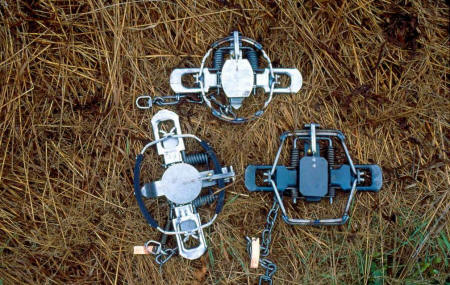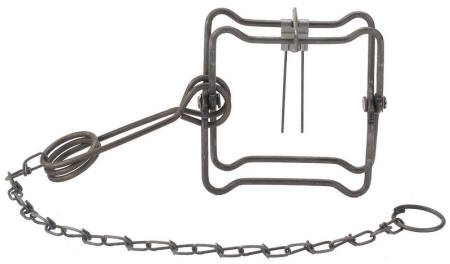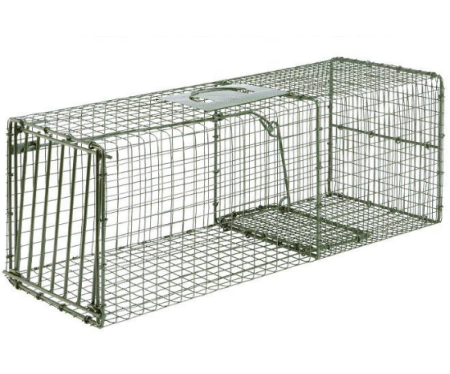Traps Today
Myths and Facts

FACT: Foothold traps are not a threat to humans. Commonly used types and sizes spring harmlessly beneath human feet. Attended pets can be released easily, without harm, by simply compressing the trap springs.
FACT: Foothold trap designs continually change. Spiked or serrated jawed traps have not been commercially made for many years. Newer models offer improved swiveling, shock absorbing springs, rounded or padded jaw surfaces, and improved leverage principles that allow lesser spring pressures. All of these improvements help reduce or totally eliminate injuries.
FACT: Virtually all scientific tests confirm that regularly tended and properly sized foothold traps do not cause significant, permanent, or life-threatening injuries. Many trapped animals simply rest or nap when they discover they are effectively restrained.
FACT: Relatively few non-furbearers are caught in foothold traps set for furbearers. Trigger adjustments, selective set constructions and selective baits minimize non-target catches. Contrary to killing types of traps, foothold traps allow the release of accidental non-target catches.
FACT: Some countries have outlawed foothold traps, and investigation usually identifies countries without an abundance of wildlife, furbearers, or predators. Most countries with an abundance of furbearers or predators rely on foothold traps to manage wildlife populations and to catch damage causing animals.
FACT: Foothold traps are popular because they are versatile, work in a variety of habitat types, and work best in different soil types and weather conditions. They are also favored because they are effective for all species while still allowing for the release of unwanted catches.
FACT: Foothold traps are recognized, accepted, and endorsed by the conservation community. The U.S. Fish and Wildlife Service, International Association of Fish and Wildlife Agencies, The Wildlife Society, and a whole host of conservation organizations support the use and need for foothold traps.
FACT: Most wildlife in America is more abundant than ever before. No endangered species is threatened by trapping today, and the loss of some wild species is due to habitat destruction, encroachment, pesticides and pollution. FACT: Trapping programs are in effect to protect endangered species from predators.
FACT: Foothold traps apply pressure to two sides of an animals foot, and this causes numbness. Several blood chemistry changes also occur to foothold trapped animals which reduce or completely eliminate the perception of pain. These include higher levels of betaendorphine, cortisol, thyroxine and insulin.
FACT: Scientists have monitored many animals with radio sending units during trapping experiences. We have learned that heart rates and body temperature elevate quickly after the capture, but soon settle down to nearly normal. Video taped observations also prove trapped animals soon settle down when they discover they are securely held in a foothold trap.
FACT: Wild animals never bite themselves where they can feel pain. Some species may bite at the trap and numbed foot beneath the trap jaws, and without feeling they simply do not recognize their own foot. The vast majority of species do recognize their foot and will not bite it. Animals in foothold traps do not bite at their legs above the trap jaws because they have feeling there, and animals cannot be made to deliberately harm themselves.
FACT: Game animals and livestock with hooved feet are not threatened by foothold traps. These trap designs often spring harmlessly beneath their feet, and a tapered foot can usually be pulled from a foothold trap with a minimum of effort.
FACT: Scientific data confirms animals are only slightly stressed by a trapping experience. Measurements indicate that more stress occurs to the animal when it is being chased than occurs as a result of being trapped. Stress occurs naturally and is considered valuable for survival.
FACT: Foothold traps are much safer than other practical trap designs. Snares and body gripping traps are often lethal devices which prevent release of non- target catches. Leg snares are far less practical and contribute to more significant and permanent leg damage. Cage traps are refused by a significant number of wild species in need of population controls.
FACT: Trappers tend to try to catch the most profitable species, however, large numbers of secondary target species are also taken in foothold traps. The result is trap- ping helps to maintain healthy balances and ratios of furbearer populations. In the case of skunks, society as well as the species is served very well by trapping because these species pose a real problem to waterfowl production, human and livestock health. FACT: Concerning conservation, trapping yields a very favorable male/female ratio. More males than females of most species are trapped, and the reason for this is males are often bolder and more aggressive at trap Sets. Too, males travel further than females, and this activity is more apt to expose the males to hazards including traps.
FACT: Most traps are checked every day, and early in the morning. On average, according to research, animals are held in traps less than 8 hours in America.
FACT: No trap design can be considered 100% selective. A foothold trap set in a submerged muskrat burrow is very selective for muskrats or mink, and a bait of aspen is very selective as a beaver bait.
FACT: Foothold traps offer versatility, and they can be used as humane quick kill traps for water oriented species. Muskrats, beavers, minks, and otters instinctively dive after being caught in foothold traps, and if the trapping system doesn't allow the animal to surface for air, death occurs quickly as a result of carbon dioxide narcosis. This is thought to be the most merciful and least stressful method to achieve a humane death for species accustomed to submergence.
FACT: Most wild animals caught in traps make efforts to escape until they realize that they are securely held. Typically, wild animals will then relax until daylight, at which time they will test the trap again as it is their habit to retire to dens or other safe places during daylight hours. If not disturbed by the approaching trapper or other threats, most trapped animals simply rest during daylight hours.
FACT: Leg snares are difficult to set, are a threat to game animals and livestock, and are inefficient in different soil types and weather conditions. Leg snares do not work on short-legged species, or in water trapping situations for numerous species.
FACT: Leg snares completely encircle trapped limbs, and this often leads to permanent damage to target and non- target species alike as circulation can be completely stopped to the affected limb. foothold traps may be more apt to cause superficial skin cuts, and this is an advantage as vascular pressure and swelling are reduced or eliminated.

FACT: Body gripping traps are effective for some species in some habitat types, but several important furbearing species are too shy and will avoid the traps. Body gripping traps often render death, and this is unacceptable where they are a threat to livestock and pets.

FACT: Cage traps only have limited values because many species refuse to enter cage traps. The safest trap to use where pets might be caught, many wild animals fight the traps in attempts to escape the close confinement.
FACT: Costs are a problem, and other problems include the fact that cage traps are more difficult to transport, and they are more visible and prone to thievery.
FACT: Wildlife experts agree that traps and trapping are essential in the proper and wise management of wildlife. Because all wild species interact, and habitat is limited, population controls are needed annually to allow for reasonable health and living conditions for all wild species.